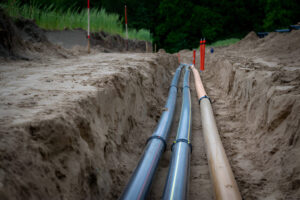How Deep Does a Water Line Need to Be? A Guide to Water Line Burial Depth
Installing a water line isn’t just about digging a trench and laying a pipe. The depth at which you bury your water line plays a critical role in ensuring it functions year-round, without the risk of freezing, breaking, or violating local building codes. Whether you’re a homeowner in Northern Colorado or planning a new construction project, understanding the correct burial depth for your water line is crucial.
At Top-Notch Plumbing, Heating & Air, we’ve spent years working with plumbing systems, making us Northern Colorado’s trusted experts when it comes to water line installation and winterization.
Understanding Water Line Depth
Water lines must be buried at a specific depth to protect them from freezing. In regions like Colorado, where temperatures dip well below freezing, the burial depth becomes even more important. But how deep does a water line need to be?
General Guidelines for Water Line Burial Depth
The burial depth for water lines depends on local frost levels and plumbing codes. As a general rule, water lines must be buried below the frost line, the depth where the ground freezes in winter. In Northern Colorado, this depth can range from 36 to 48 inches, depending on your location.
While warmer climates may allow for shallower trenches, colder regions like Greeley and Fort Collins often require deeper installations to ensure the water line doesn’t freeze. Your water line must be buried at least 12 inches below the frost line to meet local code requirements. However, a minimum depth of 6 inches below the frost line is often recommended for extra security against freezing.
Factors Influencing Burial Depth
- Local Frost Line: The frost line, or frost depth, is the depth where the soil is expected to freeze in winter. In Northern Colorado, frost depth averages 36 to 48 inches, but it can vary based on microclimates.
- Soil Composition: Soil conditions also influence how deep your water line must be buried. For example, sandy soils may freeze more quickly than clay soils, necessitating deeper burial.
- Building Codes: Northern Colorado municipalities have strict plumbing codes that require water lines to be installed at specific depths. If your water line doesn’t meet these standards, you could face fines, future repairs, or worse—burst pipes during the winter freeze.
Why Water Lines Freeze and How to Prevent It
Water freezes when temperatures drop, and if your water line is buried too shallow, the water inside can turn to ice, expanding and potentially cracking your pipes. This can lead to water outages, significant repairs, and costly damage to your property.
At Top-Notch Plumbing, we help our customers avoid these issues by ensuring their water lines are buried at the correct depth to prevent freezing, especially during Northern Colorado’s harsh winters.
Common Causes of Frozen Water Lines
- Shallow Burial Depths: Lines buried less than 12 inches below the frost line are more susceptible to freezing.
- Poor Insulation: Without proper insulation, even deeper water lines can freeze if exposed to extreme cold.
- Temperature Drops: In Colorado, where winter temperatures can plummet quickly, unprotected water lines face an even greater risk.
To prevent freezing, we recommend a combination of deeper burial and proper insulation for your water supply system.
Water Line Depth and Local Building Codes
Local building codes are designed to ensure the safety and functionality of your plumbing system. These codes dictate the minimum depth for water lines based on local climate and frost line levels.
In Northern Colorado, most local codes align with national standards like the International Plumbing Code (IPC), which states that water lines must be installed at least 12 inches below the frost line. However, Top-Notch Plumbing always goes the extra mile, recommending a minimum of 18 inches below the frost line to give you added protection against freeze-thaw cycles.
Why Hire a Professional Plumber?
While digging a trench and installing a water line might seem like a DIY project, there are several reasons why hiring a professional plumber is the best choice:
- Experience and Knowledge: A local plumber like Top-Notch Plumbing understands the regional climate and knows how deep your water lines need to be buried to avoid freezing. We account for local conditions, soil composition, and frost depth, ensuring the job is done right.
- Code Compliance: We ensure your installation complies with local building codes, so you avoid any future legal or repair issues.
- Winterization Expertise: In a region like Northern Colorado, proper water line installation is just the start. Top-Notch Plumbing offers winterization services to further protect your plumbing system from the cold.
Conclusion
If you’re installing or replacing a water line in Northern Colorado, getting the depth right is crucial to preventing frozen pipes and costly repairs. With Top-Notch Plumbing, Heating & Air, you’ll benefit from decades of experience in handling water line installations that meet local codes and withstand the coldest winters.
Contact Top-Notch Plumbing today to schedule a consultation, and let us help you protect your water supply system with expert water line installation services.
Don’t wait until winter hits—schedule an appointment with Top-Notch Plumbing today to ensure your water line is buried at the proper depth and ready to handle anything the Colorado winter can throw at it.



